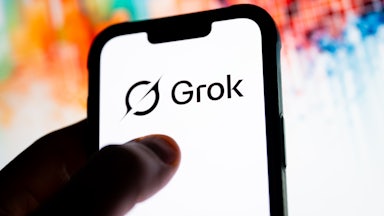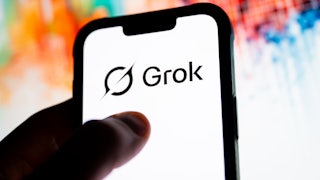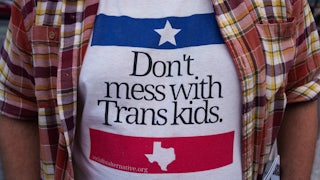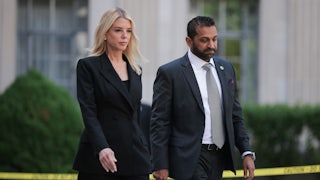It’s still possible, despite my daily exposure to horrific announcements from the Trump administration, for a White House press conference to make me sick with dread. On August 11, the president announced that he was taking federal control of the police force in Washington, D.C., and deploying the National Guard to its streets. As has become routine, Trump attempted to give legitimacy to his entirely gratuitous actions with executive orders, one declaring a nonexistent “crime emergency” in Washington, the other “restoring law and order” by directing Defense Secretary Pete Hegseth to activate the D.C. National Guard. As Trump’s press conference meandered on, various Cabinet members peppered their remarks with praise—that Trump is “saving” the city, etc. Some blocks away, at Lafayette Square, residents of our nation’s capital protested the coming occupation of the district. “While this action today is unsettling and unprecedented,” said D.C. Mayor Murial Bowser, “I can’t say that given some of the rhetoric of the past … we’re totally surprised.”
dog whistles
Trump Is Taking Over D.C. Police Because He’s a Racist Thug
Trump doesn’t care about “crime.” He cares about the right white people being in charge.

Yasin Ozturk/Anadolu/Getty Images
Flanked by Defense Secretary Pete Hegseth and Attorney General Pam Bondi, Donald Trump delivers a speech during a press conference at the White House, on August 11.
In the response to this takeover of Washington’s law enforcement, there has been a tendency to hit back with fact-checks. News stories cite statistics showing that crime in D.C. is at record lows. There is no evidence, contrary to Trump’s claims, that “caravans of mass youth rampage through city streets at all times of day.” However, as a political response to such lies, or to Trump’s invocation of “violent gangs and bloodthirsty criminals, roving mobs of wild youth and drugged-out maniacs,” along with the other racist tropes that he regularly invokes, crime numbers alone are inadequate. Uniting the blundering theater of the White House press room and the careless bombast of the executive orders is a deeper story: Today Trump has claimed the power to take over an American city, casting the city’s leadership as inept and its police as powerless “because of woke,” which is another way of saying because the right white people are not in charge.
At the press conference, an array of the right white people could be seen flanking Trump on the cramped riser. Hegseth and Attorney General Pam Bondi were there, along with other Cabinet and top law enforcement officials. But Trump’s invocation of the dangers of “woke” was evidenced by more than just the identities of the people he hired to praise him and carry out his decrees. “The radical left got out of control, and they started trying to rip down statues,” Trump said. “I found an old statute, very old, early 1900s, that said if you so much as touch or think about destroying a statue or a monument in Washington, D.C., you go to jail for 10 years, no probation, no anything.” Setting aside whatever this “very old” statute actually says or does or means, its mention showed that Trump was attempting to link his seizure of Washington’s law enforcement and his decision to send in the Guard to the very recent removal of some Confederate statues. “This was a sick, woke culture that I think we’ve largely ended,” Trump said.
Why would Trump turn to this story when announcing a police crackdown on Washington? The reference was a pointed throwback to the summer uprisings of 2020, after police in Minneapolis murdered George Floyd. But it was also a way of emphasizing that for Trump, what divides “law” from “lawlessness” is power. He’s far more invested in defending symbols of white rule, not to mention actual white rulers, than in defending people’s safety, in any city.
Eight years ago, on August 11, on the University of Virginia campus in Charlottesville, dozens of people—mostly men, mostly white—came bearing flaming tiki torches and chanting antisemitic and racist slurs to attack a small group of anti-rascist demonstrators. For many, the terrifying, indelible images from the Unite the Right rally gave the violence of the nascent Trump administration an unmistakable shape. Old-time KKK leader David Duke put it succinctly at the time: “We’re going to fulfill the promises of Donald Trump because he said he’s going to take our country back.” Trump parroted the self-justifications of this group of neo-Nazis, white nationalists, and others of the so-called alt right, arguing that their presence in Charlottesville was merely “to protest the taking down of, to them, a very, very important statue” of Confederate General Robert E. Lee. Such hollow distinctions collapsed once some of the same people stormed the Capitol on January 6, 2021, defacing the building, assaulting law enforcement, and threatening members of Congress. In Trump’s reasoning, whether they were defecating on congressional offices or chanting, “Hang Mike Pence,” these people were protesting, this time, the “taking down” of their president.
The recent talk of “law and order” among Trump and other officials is, as it usually is in this country, a fearmongering political maneuver. It is meant to link alleged incompetence and lawlessness with the political participation or even the mere visibility of Black people, immigrants, or women—all those whom our leaders have claimed at multiple points throughout our history lack the capacity to govern themselves, let alone others. Trump warned other “very bad” cities—Chicago, Los Angeles, New York, Baltimore, Oakland—that after D.C., they would be next. All of these cities have Black mayors. “We’re not going to lose our cities over this,” Trump said.
It’s been only around 50 years that D.C. residents have been able to vote for president, or even for their own mayor and City Council. Their fight for home rule is also a struggle for Black self-representation, as Martin Austermuhle recounted at The 51st, a nonprofit Washington news site. The fight stretches back to the days of Reconstruction and through the Civil Rights Movement to this moment. After the Civil War, it was white residents, Austermuhle wrote, who “pushed back on an elected mayor and council altogether because Black residents had been given the right to vote in those elections—and were winning council seats.”
In the presser, Trump’s tough guy talk veered from D.C. museums to the border, from disorder to dissent, from protesters to “criminals.” He accused some of “spitting” in cops’ faces. “And I said, ‘You tell them you spit and we hit,’ and they get hit real hard.” He claimed, of police, “They’re not allowed to do anything. But now they are allowed to do whatever the hell they want.” Trump is purportedly empowering the police in Washington, perhaps even some of the officers who surely remember that when they were under assault on January 6, Trump took hours to call in the National Guard.
The president is entirely consistent in his regard for the law. He ordered D.C. police to “do whatever the hell they want” to whomever he says is a “criminal,” and on his first day in office in 2025, he pardoned 1,500 people convicted of assault and property destruction on January 6. Crime is fine, if it’s for Trump. Then it’s not even crime—it’s just power. And power is getting to define what crime is.





